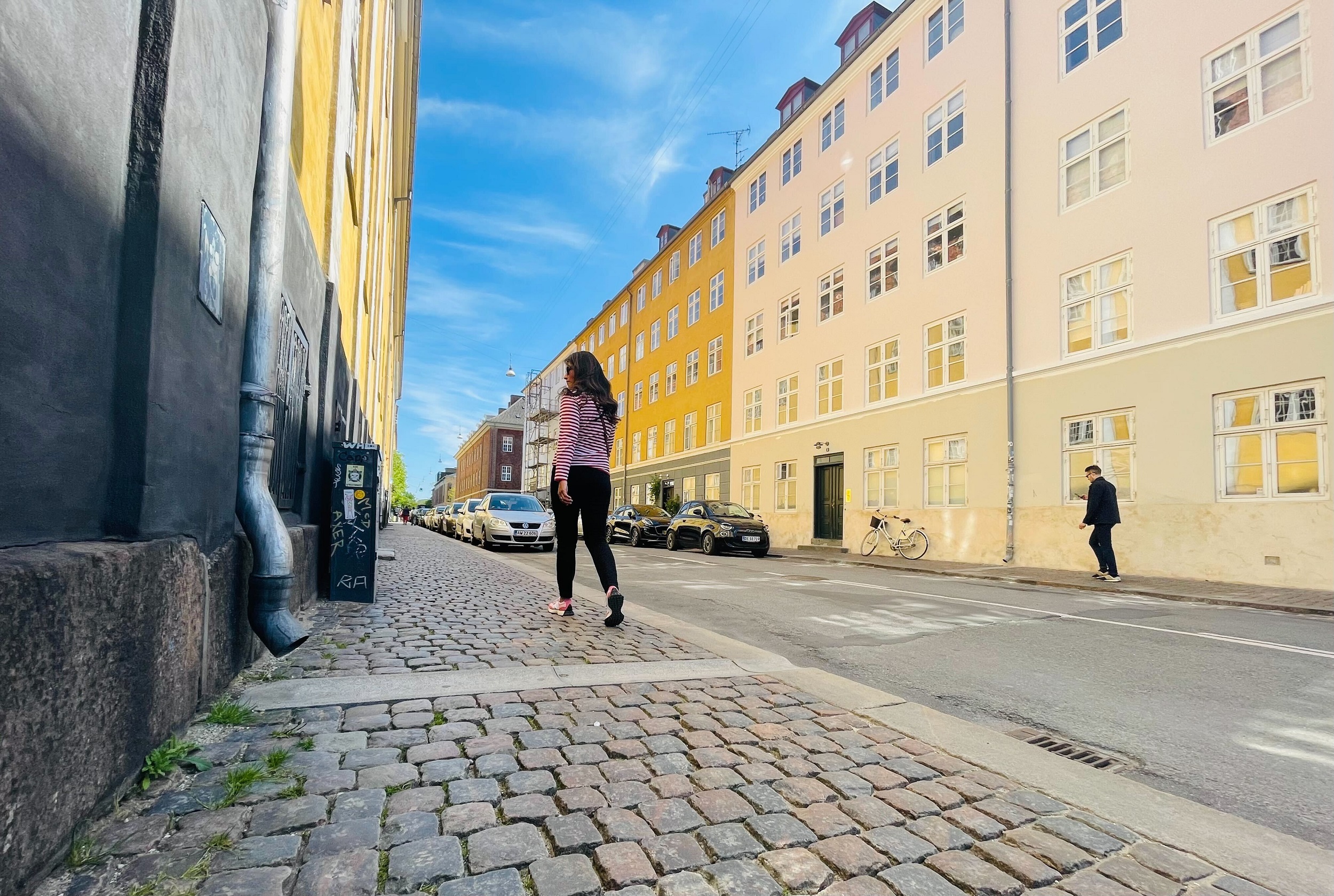

15-minute city – from a concept to measurement
15-minute city concept aims to make urban areas adapt to humans, and not the other way around. But how far our cities are from the concept?
Some weeks back, we dove into the 15-minute city concept, which aims to make urban areas adapt to humans, and not the other way around. We could say that the benefits of the 15-minute cities are clear, but how far from them are our current cities? To understand this, we first have to measure our cities of today by their reachability.
This time we fly to Denmark to roam around its beautiful neighbourhoods’ data and insights, concretely in Aarhus and Copenhagen. In our analysis, we will follow the three levels of sheds that are used as standards in the 15-minute city concept.
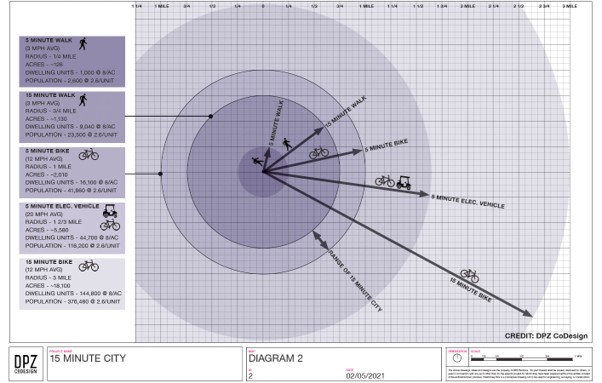

The three shed levels are:
1.The 5-minute walk shed, indicating the individual neighbourhood, which must have ordinary daily needs, a range of housing types, small businesses, and a center (e.g., public square or main street).
2.The 15-minute walk shed, the maximum distance that most people are going to walk, which must have a full mix of uses to provide for weekly and daily needs, including a grocery store, pharmacy, general merchandise, and public schools. Also, larger parks that serve multiple neighbourhoods, larger employers, and access to regional transit (at least one station). This shed is similar in size to a 5-minute bicycle shed.
3.The 15-minute bicycle shed provides access to special needs, such as major cultural, medical, and higher education facilities, regional parks, major employers, and intercity transit.
Aarhus is Denmark’s second-largest city and Jutland’s largest, with an urban population of around 280,000. Aarhus is the lively cultural hub of Jutland, as Danish youths flock here to study, innovate and start businesses. It’s also one of the oldest cities in Scandinavia.
Aarhus in numbers:




Taking one of the areas with the highest Service Diversity in Aarhus as a central point, we can go one step further and calculate the extension around it that would comprise the 15-minute city of a person living there. In other words, the Reachability.
This way, we zoom into Trøjborg, a neighbourhood developed as a working-class district in response to rapid population growth in the early 20th century, with a population of approximately 11.000 inhabitants. The exact area measured has its centre in the crossing between Nordre Ringgade and Skovvangsvej, North-East from the University of Aarhus.
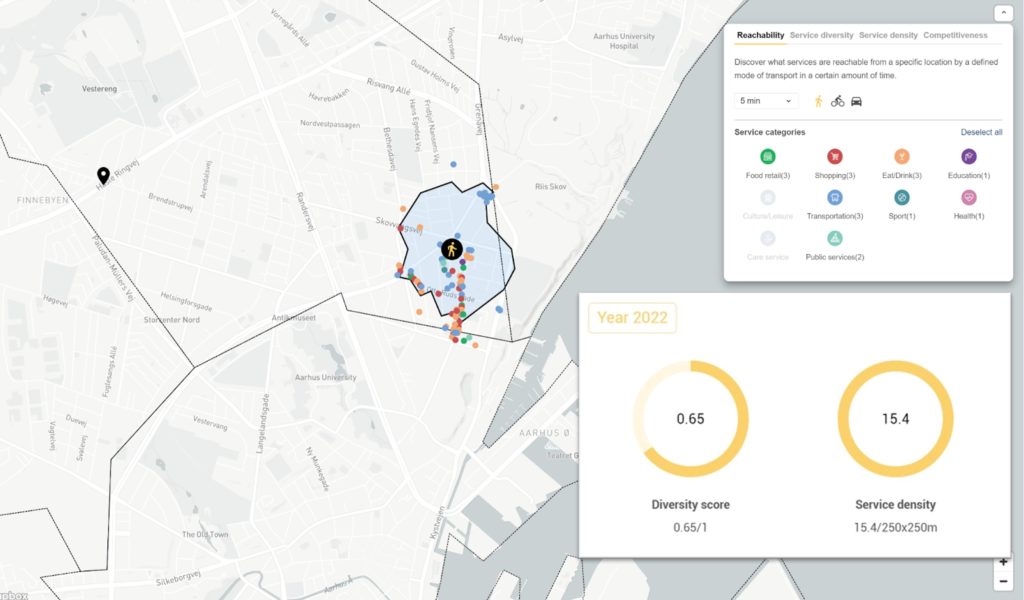

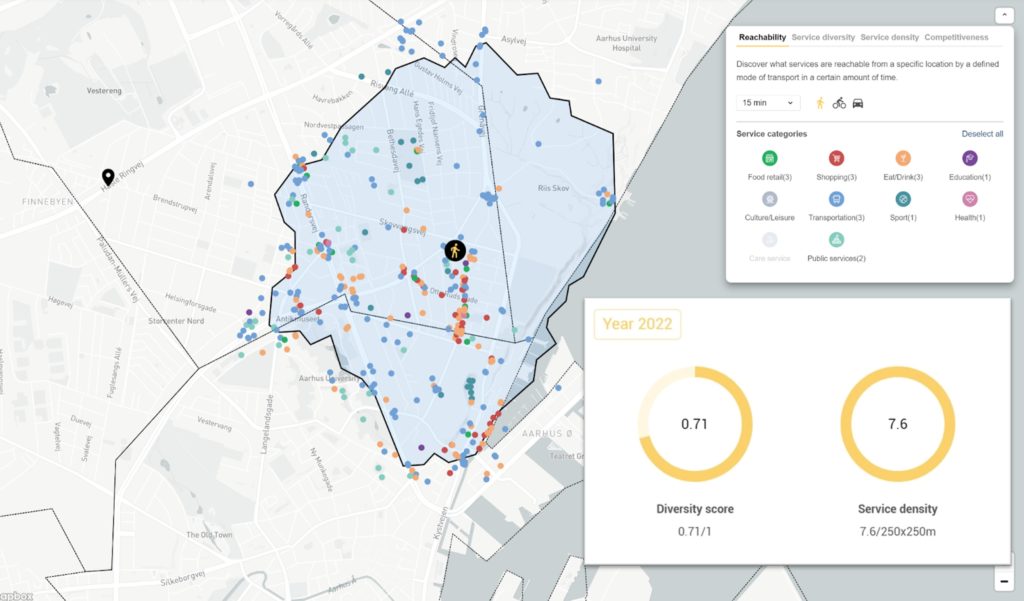

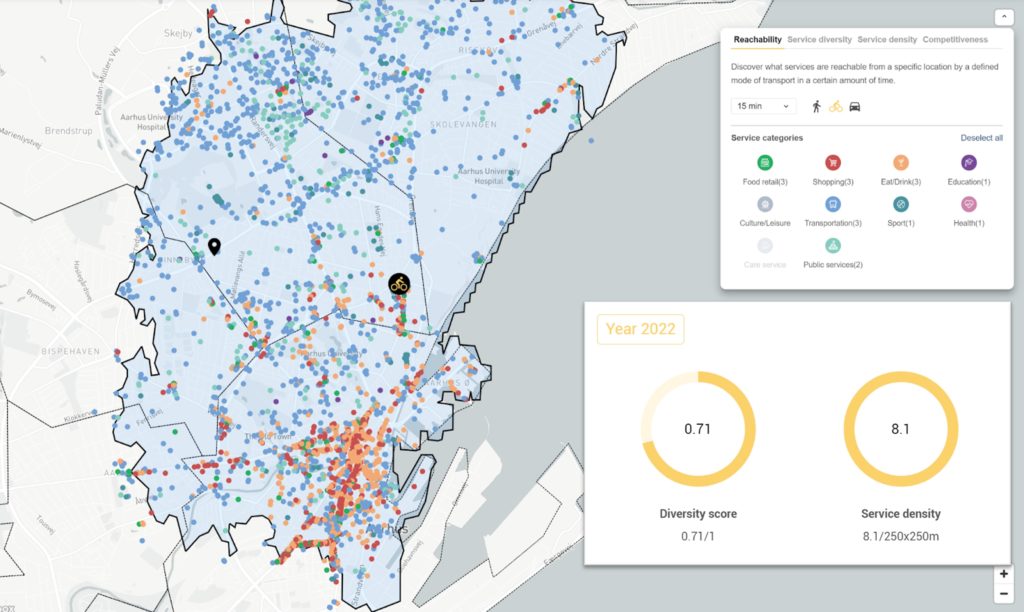

It appears that the diversity of the services reached in a 15-minute walk is not less than that reached in a 15-minute bike trip. However, we can observe how, when reduced to a 5-minute walk, no cultural and leisure services can be reached.
Greater Copenhagen is a trendy, vibrant, and sustainable metropolis with an ingrained cycling culture. Its districts have distinctive characters and represent different periods. Copenhagen is recognised globally as an exemplar of best practice urban planning.
Copenhagen in numbers:
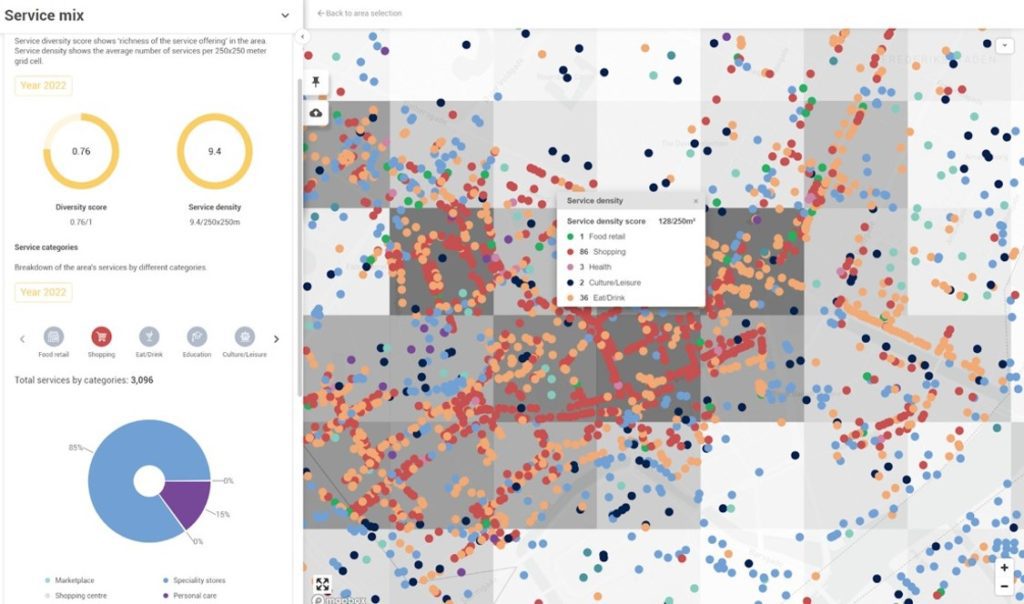



Copenhagen’s most service-diverse area is in Amager Øst district, with centre in Strandslosvej, between Lergravsvej and Jenagade. Amager Øst has a population of 49.705, and its very own identity, as it’s located on an island, with bridge connections across the harbour to central Copenhagen. It is home to Amager Strandpark, the most popular beach among Copenhageners.
Most of the services in this area are located along Amagerbrogade, the main shopping street. The most common services in the area are Restaurants (253), Speciality stores (221), and Outdoor sports facilities (131).
Despite the high service density, there are no care services in the area, for example, elderly homes.






Based on our quick analysis, Amager Øst (Copenhagen) has 1,5 times higher Service Density than Trøjborg (Aarhus), but also 4,5 times more population. This means that the number of services per inhabitant is lower in Amager Øst. However, the diversity of the services is quite similar in both cities.
Furthermore, It is interesting to note that the Service Diversity score in Amager Øst reveals that its inhabitants would be reaching a good share of services by walking 15 minutes and wouldn’t need to resort to cycling, at least from an accessibility perspective.
All the main services, including cultural and leisure amenities, are reachable even with a 5-minute walk, making this a good 5-minute neighbourhood candidate from the service provision perspective.
The recent pandemic has reshaped our commuting habits. As our neighbourhoods become our workplace locations, a more local way of life is made possible. This way, the importance of analysing urban areas from the 15-minute city and 5-minute neighbourhood perspective is higher than ever. Only in this way we can understand what future development is necessary for our areas to ensure the quality of life.
However, good service provision is not the only thing that makes an area diverse. There are other factors that a 15-minute city and a 5-minute neighbourhood must contain to ensure liveability and avoid cultural displacement. At CHAOS, we also analyse locations from these perspectives, which we are looking forward to share with you in our upcoming blog posts. If you would like to see your neighbourhood featured in our analyses, drop us a line.
CHAOS’ Service Mix dashboard provides scores on areas’ Service Density and Service Diversity. This provides insight not only into the number of services, but on the richness of the different types of offerings in the area.
CHAOS’ Reachability refers to the area created within all points that can be reached by a user-defined mode of transport at a certain time, in every direction surrounding the point of origin, considering accessibility.


Paloma Bautista actively pursues sustainable urban development powered by technology, data, and people, as the key to creating liveable cities for everyone. She holds a Master’s in Architecture and previously worked for the consultancy company serving Spain’s Ministry of Development. At CHAOS, she provides leadership and vision to ensure the business has effective people, operational controls, and administrative procedures in place. She is full of bad jokes, and is passionate about painting, dancing, and Excel sheets. Her superpower is to make things happen.


15-minute city concept aims to make urban areas adapt to humans, and not the other way around. But how far our cities are from the concept?


CHAOS together with City of Helsinki and YIT to start Maria Development Project till 2023 In the heart of Helsinki, the role of Maria 01


Data is everywhere and the amount of data has been increasing exponentially. Still, many businesses rely on old-fashioned measures or base their business decisions on gut feelings instead of data.